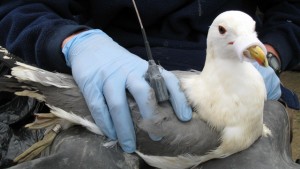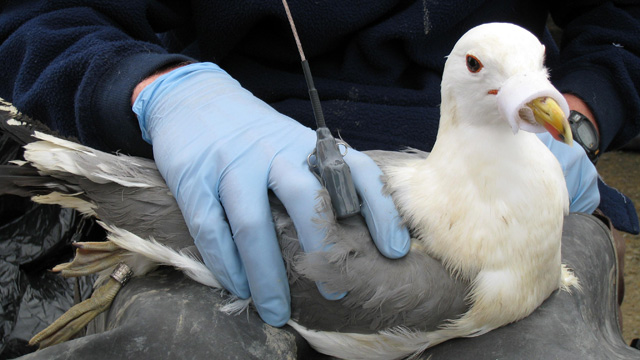How gulls time their arrival so well is a little bit of a mystery. But their numbers have grown so high that the ballpark is considering bringing in a falcon to scare them away. But that's not possible everywhere...
South Bay Shorebirds on the Menu
At the southern end of the bay near Alviso, a crew from the US Geological Survey is working on a small island in the middle of a former salt pond. It's home to a colony of Forster's terns.
"Hey, what was the band number on that chick?" asks Garth Herring, one of the scientists on the project. The team measures and bands the small, speckled tern chicks. A few of them get radio transmitters.
"When that transmitter is attached to a live chick, the transmitter beeps at a very specific rate," says Herring.
If the chick dies, the beep slows down. But you might wonder – why do they need to know if a chick is dead?
"Just to the north of us roughly about a mile, there's one of the largest California gull colonies. They'll come in, grab the chick. And they get back to the gull colony and they regurgitate to their chicks," he says.
At which point the tern chick – and transmitter – is inside the gull – until it passes through, that is. That's when Herring and his team go looking for it.
"It's pretty common that we find just a small pile of bones, the radio transmitter and the band that was associated with that Forster's tern chick," says Herring.
Herring says they've found that gulls only prey on the terns at certain times of day. "It's timed pretty well with when the local landfill sites are closing down. They're flying back to the colonies and are picking up chicks probably around 6 o'clock on average."
Last year, 40 percent of the tern chicks they tagged were eaten by gulls. "It certainly does suggest that California gulls do have the potential to have a big impact on these breeding water birds here," he says.
Gulls Gone Wild
"They're the big bully," says Cheryl Strong , a biologist with the U.S. Fish and Wildlife Service. "They're very opportunistic and they do really well with humans."
California gulls didn't always call San Francisco Bay home. In the 1980s, a small group began nesting on one of the salt ponds. Now, that population has exploded.
"California gulls are one of the earliest nesting species and they're also probably the most aggressive. So they show up first that they can easily take over an area," says Strong.
The South Bay Salt Pond Restoration Project has spent millions restoring pond habitat for Forster's terns, American avocets and the threatened western snowy plover.
But it's a conservation Catch-22. As more habitat is restored for shorebirds, it also creates more habitat for gulls. And as former salt ponds are flooded during the restoration, the gulls are looking for new places to nest.
"With 40,000 gulls, there's not a lot of room for other birds," says Strong.
Strong says the Fish and Wildlife Service is writing a plan to manage the gulls. One option is killing the birds. But gulls can live up to 25 years and with an endless food source at landfills nearby, she says there's only so much they could do.
"If you're talking about removing birds lethally, it's just not feasible. They are a part of our landscape, like it or not," she says.
For now, they're trying something else.
Gull Hazing Underway
"So up ahead there are some gulls doing some courtship behaviors on the levee which is definitely a bad sign," says Caitlin Robinson-Nilsen of the San Francisco Bay Bird Observatory. She's looking at a large flock of gulls on a salt pond near Fremont.
"This is one of the areas where we definitely don't want them to nest. One of the salt ponds we're standing right next to is a historic nesting site of the western snowy plover."
So, Robinson-Nilsen's job is to haze the gulls. She uses a whistle and walks down the levee. The gulls aren't happy about it.
"They'll dive bomb you and hit you in your head. They're very good at pooping you. They have pretty good aim that way."
Robinson-Nislen says they're hazing gulls twice a day to keep them from nesting next to sensitive shorebirds. So far, it looks like it's working. But with millions of tax dollars being spent on restoring more habitat, biologists expect they'll be doing a lot more gull management in the years ahead.
Additional Links

